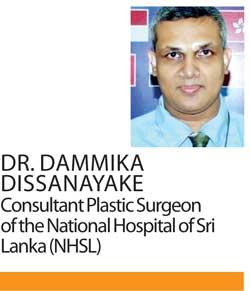

When making first impressions, what is more important than your face? Attitude, one might answer and he would probably be right. However, it is no secret that ones face plays a major role in his life as it serves as part of one’s identity as well as one’s first impression when he takes a seat at his job interview.
The Consultant Plastic Surgeon of the National Hospital of Sri Lanka (NHSL) Dr. Dammika Dissanayake defines craniofacial anomalies as deformities that affect one’s head and face. These disorders are typically present at birth (congenital) and can range from mild to severe. In some cases, especially among adults, deformities can be acquired as a result of trauma or neoplasm.
Cleft and Craniofacial Awareness and Prevention month is observed every July to not only bring awareness to cleft and craniofacial defects but to share available resources for families.
Common Examples
There are numerous congenital craniofacial anomalies.

Cleft lip and palate- Facial cleft deformities including cleft lip and palate are the most common type of craniofacial anomaly where a gap occurs in the lip or the palate (roof of the mouth), or both. Cleft lip is an abnormality in which the lip does not completely form. The degree of the cleft lip can vary greatly, from mild (notching of the lip) to severe (large opening from the lip up through the face). Cleft palate is where the roof of the mouth does not completely form; leaving an opening that can extend into the nasal cavity. The cleft lip may involve both sides. Cleft palate can extend from the front of the mouth (hard palate) to the throat (soft palate) or it can involve only the back.
Anotia and microtia- These are birth defects of a baby’s ear. Anotia happens when the external ear (the part of the ear that can be seen) is missing completely. Microtia happens when the external ear is small and not formed properly.
Dermoid cysts- They are lumps located on or under the skin. They occur during fetal development and are typically present at, or shortly after, birth, especially in the forehead area and outer angle of the eye
Ptosis- Ptosis is when the upper eyelid droops over the eye. The eyelid may droop just a little, or so much that it covers the pupil (the black dot at the center of your eye that lets light in).
Hemifacial microsomia – This is a condition in which the tissues on one side of the face are underdeveloped.
There are many more deformities in relation to ears, nose, scalp, skull, cheeks, teeth, facial nerves, etc. that falls under craniofacial anomalies. The cause for most of the congenital anomalies is unknown. It may be due to genetic or environmental factors. “One thing we know is that consanguineous marriage, i.e. marriage between first degree relatives can increase the risk of congenital craniofacial anomalies,” Dr. Dissanayake said.
Other than these congenital anomalies, deformities may be acquired such as lacerations, cut injuries, burns, nerve injuries, etc.
“There is no end to the craniofacial anomalies and injuries” Dr. Dissanayake insisted.
Dangers of craniofacial anomalies and Treatments
According to Dr. Dissanayake, some craniofacial anomalies, if not treated, may have a detrimental effect on a healthy life. For example, due to Cleft lip and palate anomaly, feeding maybe difficult which would result in poor growth. Therefore they must be managed earlier in life.
Infection of certain craniofacial injuries may cause brain infections which were life threatening. Sometimes the craniofacial injury itself may cause brain injuries.
Other than that, the unsightly nature resulted by craniofacial anomalies can affect the psychological wellbeing of a person.
“Most craniofacial anomalies can be treated surgically, mostly by plastic surgeons,” Dr. Dissanayake explained. According to him, at the present, there were surgical procedures which can treat these anomalies while ensuring minimal scarring. There are surgeries to treat scarred tissue/skin as well. Some of these surgeries might be multiple staged.
Better treatment for these anomalies could be provided early on in life. However, they could be treated later on in life as well.
Dr. Dissanayake emphasised that patients should not take facial injuries lightly and it was important to seek advice from qualified medical officers, especially plastic surgeons in treating these injuries.

 When making first impressions, what is more important than your face? Attitude, one might answer and he would probably be right. However, it is no secret that ones face plays a major role in his life as it serves as part of one’s identity as well as one’s first impression when he takes a seat at his job interview.
When making first impressions, what is more important than your face? Attitude, one might answer and he would probably be right. However, it is no secret that ones face plays a major role in his life as it serves as part of one’s identity as well as one’s first impression when he takes a seat at his job interview.